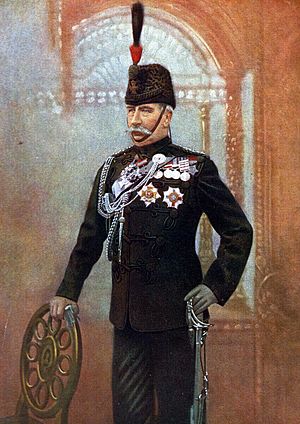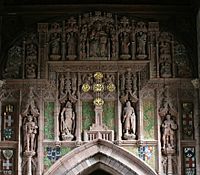Redvers Buller facts for kids
Quick facts for kids
Redvers Buller
|
|
|---|---|
 |
|
| Born | 7 December 1839 Crediton, Devon |
| Died | 2 June 1908 (aged 68) Crediton, Devon |
| Buried |
Holy Cross Churchyard, Crediton
|
| Allegiance | United Kingdom |
| Service/ |
British Army |
| Years of service | 1858–1901 |
| Rank | General |
| Unit | King's Royal Rifle Corps |
| Commands held | Aldershot Command British Forces in South Africa Adjutant-General to the Forces Quartermaster-General to the Forces |
| Battles/wars | Second Anglo-Chinese War Anglo-Ashanti wars Xhosa Wars Anglo-Zulu War First Boer War Anglo-Egyptian War Mahdist War Second Boer War |
| Awards | |
General Sir Redvers Henry Buller (born December 7, 1839 – died June 2, 1908) was a very brave officer in the British Army. He received the Victoria Cross, which is the highest award for bravery in battle given to British and Commonwealth soldiers. He was in charge of British forces in South Africa during the start of the Second Boer War. Later, he led the army in Natal until he went back to England in November 1900.
Contents
Early Military Career
After studying at Eton, Redvers Buller joined the 60th Rifles in May 1858. He fought in the Second Opium War and became a captain. He also took part in the Canadian Red River Expedition in 1870.
From 1873 to 1874, he was an intelligence officer. This means he gathered important information for Lord Wolseley during the Ashanti campaign. He was slightly hurt in a battle called Battle of Ordabai. After this, he was promoted to major.
Bravery in the Zulu War
Buller then served in South Africa during the 9th Cape Frontier War in 1878. He also fought in the Anglo-Zulu War of 1879. In the Zulu War, he led the mounted infantry, which were soldiers on horseback. They were part of the northern British column.
He fought in the Battle of Hlobane, where the British faced a defeat. Here, he showed great bravery under fire and was given the Victoria Cross. The very next day, he fought in the Battle of Kambula, where the British won. After the Zulu attacks were stopped, he led his mounted troops in a fierce chase of the fleeing Zulu warriors.
In June 1879, he again led mounted troops at the Battle of Ulundi. This was a major British victory that helped end the war.
Service in Other Conflicts
In the First Boer War of 1881, Buller was the chief of staff for Sir Evelyn Wood. The next year, he was again in charge of intelligence during the Egypt campaign. For his service, he was made a knight.
In 1882, he married Audrey, the daughter of the 4th Marquess Townshend. That same year, he was sent to the Sudan. He commanded an infantry brigade and fought in battles like El Teb and Tamai. He was also part of the mission to help General Gordon in 1885. He was then promoted to major-general.
He went to Ireland in 1886 to investigate police misconduct. He returned to the Army as Quartermaster-General to the Forces the next year. In 1890, he became Adjutant-General to the Forces and was promoted to Lieutenant general. On June 24, 1896, Buller was promoted to full General.
Challenges in the Second Boer War
Buller became the head of troops at Aldershot in 1898. When the Second Boer War started in 1899, he was sent to South Africa to command the Natal Field Force.
He faced defeats during what became known as Black Week. This included the Battle of Colenso. Other forces under his command also suffered losses at the Battle of Magersfontein and Battle of Stormberg. Because of these problems, he was replaced as the overall commander in South Africa by Lord Roberts in January 1900. Some soldiers even started calling him "Reverse Buller" because of the early defeats.
He stayed as second-in-command. He faced two more setbacks trying to help the city of Ladysmith at the battles of Spion Kop and Vaal Krantz.
Relief of Ladysmith
On his fourth try, Buller finally won the Battle of the Tugela Heights. This victory ended the siege of Ladysmith on February 28, 1900. This was the day after another Boer leader surrendered to Lord Roberts. After Roberts captured Bloemfontein, Buller correctly predicted that the Boers would start fighting using guerrilla tactics. Later, Buller successfully outmaneuvered Boer armies from their positions at Biggarsberg, Laing's Nek, and Lydenburg. His experienced soldiers won the Battle of Bergendal, which was the last big battle of the war.
Dismissal from Service
Buller was very popular with the public in England. He received a hero's welcome when he returned from South Africa. However, his reputation had been hurt by his early losses in the war. When people in England became worried about the ongoing guerrilla fighting, the Minister for War and Lord Roberts looked for someone to blame.
Buller gave a speech on October 10, 1901, responding to criticism in a newspaper. This gave his opponents a chance to act. On October 17, he was asked to resign for breaking military rules. Buller refused, so he was dismissed from the army on half pay on October 22. His requests for a military trial or to appeal to the King were denied.
Later Life and Legacy

Many people felt sympathy for Buller, especially in the West Country of England. In 1905, people raised money to build a famous statue of Buller riding his war horse in Exeter. This statue was made by Adrian Jones.
Buller described himself as a Whig and a Liberal Unionist. He was offered chances to run for Parliament but turned them down. He lived a quiet retirement until he accepted a role with the Goldsmiths' Company in 1907, which he held until his death.
Historians have different views on Buller. Some say he was a great leader of small groups of soldiers but struggled when in charge of larger armies. Others praised his strong character and determination.
Family Life
In 1882, when he was 43, he married Lady Audrey Jane Charlotte Townshend. She was a widow and the daughter of the 4th Marquess Townshend. They had one child, a daughter:
- (Audrey Charlotte) Georgiana Buller (1884–1953). She received an award for her service as an administrator in War Hospitals in Exeter during World War I. She never married.
Death and Burial
Buller died on June 2, 1908, at his family home, Downes House, in Crediton, Devon. He is buried in the churchyard of Holy Cross Church in Crediton. Inside the church, there is a large and detailed monument to Sir Redvers.
Places Named After Buller
Many places are named after General Buller, showing his lasting impact.
In England
- The Royal Corps of Transport barracks in Aldershot is named after him.
- There is a road in North Camp and Buller Court in Farnborough.
- Two roads in Tottenham, London, are called Redvers Road and Buller Road.
- You can find Redvers Buller Road in Chesterfield.
- There's a Buller Street in Derby, and Buller Road and Mews in Bury, Lancashire.
- In Chatham, there are Redvers Road and Buller Road next to each other.
- Leicester also has a Buller Road.
- Brighton has a Redvers and a Buller Road.
- In Exeter, Buller Road is near Redvers Road.
- Exeter School has a house named Buller House.
In Canada
- In British Columbia, Buller Street in Ladysmith is named after him.
- The town of Redvers, in Saskatchewan, is named after him.
- In Ontario, Buller Street in Woodstock is named after him.
In Trinidad and Tobago
- Buller Street in Port of Spain is one of several streets named after British Army officers who were important in the Second Boer War.
Monuments and Memorials

His Victoria Cross medal is on display at the Royal Green Jackets (Rifles) Museum in Winchester, England.
Winchester Cathedral
There is a memorial to Buller in Winchester Cathedral. It shows a statue of him lying down. The words on it say, "A great leader – Beloved of his men."
Exeter

A bronze statue of Buller on his horse is in Exeter. It was made by Adrian Jones in 1905. It stands near Exeter College.
Crediton
The whole western side of the chancel arch inside Holy Cross Church in Crediton is a detailed monument to Buller. It was designed by William Douglas Caröe. There is also a brass plaque in Crediton Church put there by his daughter, Georgiana Buller. A local pub in Crediton is also named after him.



